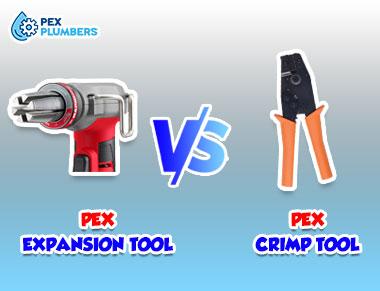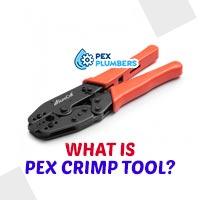There’s hardly any disagreement that PEX (known as cross-linked polyethylene) is an excellent choice for plumbing. It has become a new standard for water pipes due to its bendability, ease of joining, corrosion resistance, and lightweight nature.

However, opinions vary on two of its popular connection fittings (the methods of joining the pipe sections together) — the Expansion and Crimp. And choosing between these two is a real challenge.
Therefore, our team of experts has wisely differentiated Pex Expansion Vs Crimp.
This article illustrates the differences in detail to eliminate every bit of your confusion. So you won’t be scratching your head anymore while choosing the connection fitting for the repiping task!
Let’s find out which one could make the best choice for you.
What is PEX Expansion tool?

Let’s start with the PEX Expansion fitting first. PEX Expansion tool (also known as cold expansion) is a type of PEX tubing (generally PEX-A) that uses an expansion method to connect the tubing and fittings.
There’s an expansion ring, a larger diameter pipe, and an outer plastic sleeve that’s overlapped at the pipe end. As a result, it easily expands to insert a fitting. This fitting method helps in stronger bonds by ensuring a water-tight seal.
Advantages of PEX Expansion
PEX is the new and unique piping solution that comes out best with Expansion fittings. There are some good reasons that make PEX expansion to be a new favorite. Let’s take a look at a few of these.
- Easy and quick to install.
- Offers excellent flow with no pressure drops.
- Less tool calibration needed.
- It doesn’t need any complex tool for installation.
- More resistant to corrosion and oxidation.
- It makes fitting stronger over time.
What is PEX Crimp Tool?

Crimp is the most popular and affordable PEX fitting style. It’s available in brass and poly alloy construction that are manufactured to ASTM F1807, ASTM F2159 standard respectively. Both these Crimp fittings are compatible with all kinds of PEX tubing.
Its installation requires stainless steel or copper Crimp Rings along with a Fitting Crimp Tool. This Crimp Tool joins two metal or ductile (wires or metal plates) pieces together.
A few manufacturers use O-rings on the metal fittings for making the seal with the PEX tubing.
You may also like this article – How to dissolve toilet paper in a sewer line
Advantages of PEX Crimp
Besides being a relatively inexpensive option, there are some other advantages to the PEX Crimp fittings. Some of these include:
Firstly, PEX crimping is a simple and efficient method of joining pipes. It requires only a few basic tools and can be done quickly, making it a cost-effective option for many applications. Unlike traditional soldering or brazing methods, PEX crimping does not require a high level of skill or training, making it accessible to both professionals and DIYers.
Secondly, PEX crimp fittings is a reliable method of joining pipes. When done properly, crimping creates a strong and long-lasting seal that is less likely to leak than other joining methods. The copper crimp ring compresses the PEX pipe around the fitting, creating a watertight seal that is resistant to corrosion, scale buildup, and freeze damage. This makes PEX crimp tool an ideal option for hot and cold water supply systems, as well as for radiant heating systems.
Another advantage of PEX crimp fittings is its flexibility. PEX piping is flexible and can bend around corners, making it easier to install in tight spaces. The crimp rings used in PEX crimping are also available in a variety of sizes and materials, allowing for customized crimps that are tailored to the specific needs of the application. This flexibility makes PEX crimping an ideal option for retrofitting existing plumbing systems.
PEX crimping is also a clean and environmentally friendly method of joining pipes. Unlike soldering or brazing, which require the use of chemicals and can create hazardous fumes, PEX crimping does not produce any toxic substances. Additionally, PEX piping is resistant to scale buildup, making it a more sustainable option for hot water supply systems.
Finally, PEX crimping is a reversible method of joining pipes. Unlike soldering or brazing, which create permanent joints that cannot be easily undone, PEX crimping can be undone and the pipes can be repositioned or replaced if necessary. This makes PEX crimping a more flexible and adaptable option for plumbing and heating systems.
In conclusion, PEX crimping offers numerous advantages over traditional joining methods, making it an ideal option for many plumbing and heating applications. Its simplicity, reliability, flexibility, and sustainability make it a popular choice for both professionals and DIYers. As PEX piping continues to gain popularity in the industry, PEX crimping is likely to become an increasingly important joining method for years to come.
PEX Expansion fittings Vs PEX Crimp: Difference Between Them
Two of the most common methods of joining PEX pipes are expansion and crimping. Expansion involves stretching the PEX pipe over an expanded ring and then allowing it to shrink back to its original size, creating a secure seal. Crimping involves compressing a metal ring around the PEX pipe and fitting to create a seal.
The main difference between expansion and crimping is the type of tool used to create the seal. Expansion requires a specialized tool that stretches the PEX pipe, while the crimp system requires a tool that compresses a metal ring. Expansion is typically used in larger diameter pipes and is less likely to create leaks, while crimping is more versatile and can be used in a wider range of applications. Ultimately, the choice between expansion and crimping will depend on the specific needs of the application and the preferences of the installer.
It’s time to discuss the actual differences between these two PEX fittings. Here we’ll see some points of difference to understand which one excels where.
Once you make your decision, you can visit the Uponor website here, a leading brand for residential and commercial PEX products.
Manufacturing Standard
The PEX Expansion fitting has to be manufactured to the ASTM F1960 standards. On the contrary, the brass and plastic PEX Crimp fittings have to be manufactured to ASTM F1807 and ASTM F2159 standards respectively.
Relevant post >> How Long Does Pex Piping Last
Installation
The Expansion style doesn’t require a PEX Expansion tool, instead, it requires the application of an expansion valve. It needs to be tested after 24 hours.
Whereas, the installation of the Crimp requires the application of a Crimp tool, Crimp Ring, and other tools that need calibration. And its testing has to be done instantly.
Efficiency and Durability
PEX Expansion fittings are more durable in extreme conditions such as colds, frozen pipes, and so on. These fittings also have fewer leaks than their counterparts.
They also work well in tighter spaces. On the other hand, Crimp fittings are inexpensive and not as durable as the Expansion.
Compatibility
Expansion fittings are only compatible with PEX-A tubing, while the Crimp fittings are compatible with all kinds of PEX tubing, including A, B, and C. Crimp fittings are also readily available at stores while Expansion needs a bit of effort to put together.
Temperature Effect
PEX expansion responds to temperature while the Crimp doesn’t. In expansion, the temperature can affect the total expansion number needed for the fitting.
You may also like – 7 Best PEX Crimp Rings in 2023 – Reviews & Buyer’s Guide
Which One Is For Me?
If you’ve a home improvement plan or a repipe task at hand, you need to know which type of PEX fitting you should be adopting. From the above discussion, you should’ve been clear about which fitting type excels where.
What we see from the discussion is that the PEX Crimp is a more common and affordable option out of the two. It’s widely compatible, flexible, easy, and effective as well. However, the internal diameter is smaller and mightn’t be as effective as its counterpart. It’s also less durable than Expansion.
On the other contrary, you’ve a more sophisticated PEX Expansion fitting which is adopted by trained professionals and plumbers. It’s highly flexible, allowing it to get fastened by winter expansion. It also makes a great choice in terms of efficiency and durability.
After checking out their own set of pros and cons for both these PEX fittings, we’re good to state the verdict now. We think if you’re looking for a PEX fitting that’s inexpensive, readily available, and should work with regular plumbing tasks, then the Crimp makes a perfect choice.
But if you’re looking for a professional HVAC installation or other such sophisticated applications, the PEX Expansion has to be your go-to option.
Final Thoughts
You’re now schooled that using a PEX water system can guarantee a smooth and flawless experience. But you need to make sure you’re installing the fittings with the manufacturer recommended accessories and tools.
Regarding the PEX Expansion Vs PEX crimp tool competition, we don’t have a clear winner here as both these styles have their own set of advantages and disadvantages.
PEX Expansion is a more demanding fitting style. And its efficiency and durability make it the best choice for the growingly popular PEX plumbing system.
However, Crimp is a cheap and flexible option that works great as a home-improvement choice. So it’s up to your requirements and specifications that’ll determine which one you should really go for!

Hey! I’m Leanda Bailey. I’m here to explain every plumbing installation and repair you may have in your kitchen or bathroom. Also, I’ll try to find you the best products on the market for your plumbing work.
